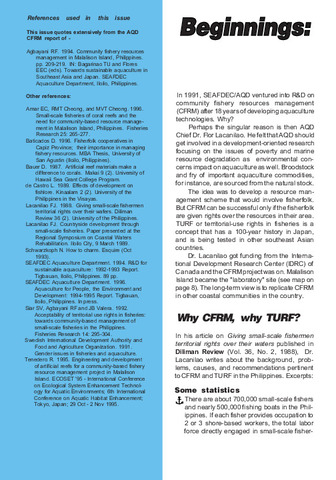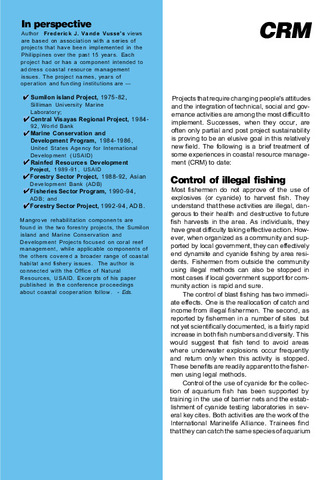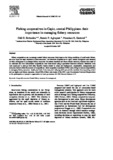Anthropological study on the coastal fisheries: harmonization of present and traditional technologies for sustainable coastal fisheries through community-based coastal resources management (CB-CRM): the Philippine experience.
| dc.contributor.author | Flores, Efren Ed C. | |
| dc.contributor.editor | Ishizuka, Kozo | |
| dc.contributor.editor | Hisajima, Shigeru | |
| dc.contributor.editor | Macer, Darryl R.J. | |
| dc.date.accessioned | 2011-06-22T09:35:53Z | |
| dc.date.available | 2011-06-22T09:35:53Z | |
| dc.date.issued | 1996 | |
| dc.identifier.citation | Flores, E. E. C. (1996). Anthropological study on the coastal fisheries: harmonization of present and traditional technologies for sustainable coastal fisheries through community-based coastal resources management (CB-CRM): the Philippine experience. In K. Ishizuka, S. Hisajima, & D. R. J. Macer (Eds.), Traditional Technology for Environmental Conservation and Sustainable Development in the Asian-Pacific Region: Proceedings of the UNESCO - University of Tsukuba International Seminar on Traditional Technology for Environmental Conservation and Sustainable Development in the Asian-Pacific Region, held in Tsukuba Science City, Japan, 11-14 December, 1995 (pp. 198–203). Tsukuba Science City, Japan: Master’s Program in Environmental Sciences, University of Tsukuba. | en |
| dc.identifier.uri | http://hdl.handle.net/10862/453 | |
| dc.description.abstract | As an archipelago country, communities in the Philippines grow along the coastal areas, and usually near a river. The main source of food and livelihood of these communities would be from their surrounding aquatic resources. Through the years, some communities grew to become the present day towns and cities or urban centers. With population growth, new communities are formed along the coastal areas along with old communities remaining as such through the years and still depending mainly from the surrounding aquatic resources for food and livelihood. This paper will concentrate its presentation on these small communities which are called "barangay", the basic political unit in the Philippines, governed by a Barangay Council headed by a Barangay Captain, who together with its members are elective government officials. The coastal barangay is referred to as the fishing community with its fishers referred to as "municipal" fishermen, or small-scale fishermen. The Philippine Local Government Code defines the fishing area for municipal fishermen as that body of marine water extending 15 kilometers seaward starting from the coastline. Fishing operations with the use of fishing vessels of three gross tons or less can operate in this fishing area or municipal fishing ground. Fish production from municipal fisheries have been increasing through the years until 1991 when production continuously decreased up to 1994. Government projections predict the municipal fisheries production up to 1998 at the 1994 level. The main causes for the decrease in municipal fisheries production are illegal fishing operation such as dynamite fishing, "muro-ami" fishing, and cyanide fishing, and overfishing as a result of growing population of fishers and number of fishing communities. | en |
| dc.language.iso | en | en |
| dc.publisher | Master’s Program in Environmental Sciences, University of Tsukuba | en |
| dc.relation.uri | http://www.eubios.info/TTEC/TTECEF.htm | |
| dc.subject | anthropology | en |
| dc.subject | Philippines | en |
| dc.subject | fishing operations | en |
| dc.subject | communes | en |
| dc.subject.lcc | VF SP 0257 | |
| dc.title | Anthropological study on the coastal fisheries: harmonization of present and traditional technologies for sustainable coastal fisheries through community-based coastal resources management (CB-CRM): the Philippine experience. | en |
| dc.type | Conference paper | en |
| dc.citation.spage | 198 | |
| dc.citation.epage | 203 | |
| dc.subject.asfa | sustainable fisheries | en |
| dc.subject.asfa | coastal zone management | en |
| dc.subject.asfa | fishing methods | en |
| dc.subject.asfa | fishermen | en |
| dc.subject.asfa | coastal fisheries | en |
Files in this item
| Files | Size | Format | View |
|---|---|---|---|
|
There are no files associated with this item. |
|||
This item appears in the following Collection(s)
-
Conference Proceedings [299]



